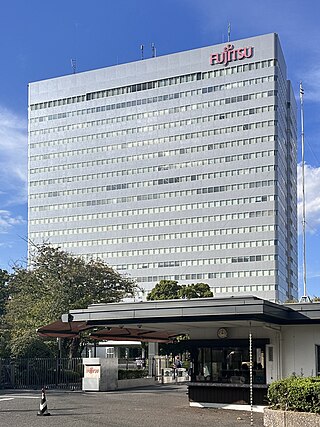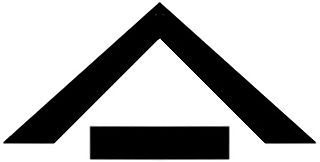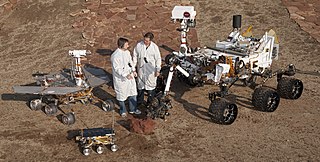
A robot is a machine—especially one programmable by a computer—capable of carrying out a complex series of actions automatically. A robot can be guided by an external control device, or the control may be embedded within. Robots may be constructed to evoke human form, but most robots are task-performing machines, designed with an emphasis on stark functionality, rather than expressive aesthetics.

SPARC is a reduced instruction set computer (RISC) instruction set architecture originally developed by Sun Microsystems. Its design was strongly influenced by the experimental Berkeley RISC system developed in the early 1980s. First developed in 1986 and released in 1987, SPARC was one of the most successful early commercial RISC systems, and its success led to the introduction of similar RISC designs from many vendors through the 1980s and 1990s.

A humanoid robot is a robot resembling the human body in shape. The design may be for functional purposes, such as interacting with human tools and environments, for experimental purposes, such as the study of bipedal locomotion, or for other purposes. In general, humanoid robots have a torso, a head, two arms, and two legs, though some humanoid robots may replicate only part of the body. Androids are humanoid robots built to aesthetically resemble humans.

Fujitsu Limited is a Japanese multinational information and communications technology equipment and services corporation, established in 1935 and headquartered in Kawasaki, Kanagawa. It is the world's sixth-largest IT services provider by annual revenue, and the largest in Japan, in 2021.

Enon was an indie rock band founded by John Schmersal, Rick Lee, and Steve Calhoon that was active from 1999 to 2011; for most of its history, however, Enon was a three-piece outfit composed of Schmersal, Toko Yasuda, and Matt Schulz. Though situated for a time in Philadelphia, Enon was known for being part of the New York music scene.

FANUC is a Japanese group of companies that provide automation products and services such as robotics and computer numerical control wireless systems. These companies are principally FANUC Corporation of Japan, Fanuc America Corporation of Rochester Hills, Michigan, USA, and FANUC Europe Corporation S.A. of Luxembourg.

Robot welding is the use of mechanized programmable tools (robots), which completely automate a welding process by both performing the weld and handling the part. Processes such as gas metal arc welding, while often automated, are not necessarily equivalent to robot welding, since a human operator sometimes prepares the materials to be welded. Robot welding is commonly used for resistance spot welding and arc welding in high production applications, such as the automotive industry.

The Fujitsu FR-V is one of the very few processors ever able to process both a very long instruction word (VLIW) and vector processor instructions at the same time, increasing throughput with high parallel computing while increasing performance per watt and hardware efficiency. The family was presented in 1999. Its design was influenced by the VPP500/5000 models of the Fujitsu VP/2000 vector processor supercomputer line.

Toko Yasuda is a Japanese singer, songwriter, keyboardist, guitarist, and bassist, best known as a member of New York indie rock band Enon and as a musician in live St. Vincent performances.

A robotic lawn mower is an autonomous robot used to cut lawn grass. A typical robotic lawn mower requires the user to set up a border wire around the lawn that defines the area to be mowed. The robot uses this wire to locate the boundary of the area to be trimmed and in some cases to locate a recharging dock. Robotic mowers are capable of maintaining up to 30,000 m2 (320,000 sq ft) of grass.

A mobile robot is an automatic machine that is capable of locomotion. Mobile robotics is usually considered to be a subfield of robotics and information engineering.
Denso Ten Limited is a Japanese company developing and manufacturing car audio, video, navigation and control systems. The headquarters is located in Kobe, Hyōgo Prefecture, Japan. As its name shows, Denso Ten belongs to the Denso group led by Denso Corp., which is the second-largest auto parts supplier in the world.

A robotics simulator is a simulator used to create an application for a physical robot without depending on the physical machine, thus saving cost and time. In some case, such applications can be transferred onto a physical robot without modification.
The HOAP series robots are an advanced humanoid robot platform manufactured by Fujitsu Automation in Japan. HOAP is an abbreviation for "Humanoid for Open Architecture Platform".

Furukawa Group formerly Furukawa zaibatsu (古河財閥) is one of Japan's 15 largest industrial groups. Its origins date back to 1875, founder Furukawa Ichibei. This group specialized in mining, electronics, and chemicals industry before World War II.

Robotics is the interdisciplinary study and practice of the design, construction, operation, and use of robots.
Robot economics is the study of the market for robots. Robot markets function through the interaction of robot makers and robot users. As a factor of production, robots are complements and/or substitutes for other factors, such as labor and (non-robot) capital goods. Another part of robot economics considers the effects of the introduction of robots on the markets for those other factors and on the products that robots help produce.
ELOT 927 is 7-bit character set standardized by ELOT, the Hellenic Organization for Standardization (HOS). It is also known as ISO-IR-88, CSISO88GREEK7 or 7-bit DEC Greek. The standard was withdrawn in November 1986. Support for it was implemented in various dot matrix printers and line printers as well as in computer terminals. Support for it can still be found in various applications, languages and protocols today, for example in Perl and Kermit.















